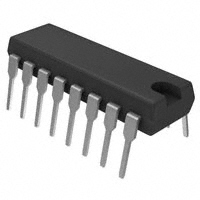1. 物料型号:
- 型号:TCA 785
- 订购代码:Q67000-A2321
- 封装:PG-DIP-16-1
2. 器件简介:
- 该相位控制IC旨在控制晶闸管、双向可控硅和晶体管。触发脉冲可以在0°至180°的相位角之间移动。典型应用包括转换电路、交流控制器和三相电流控制器。这款IC替代了之前的TCA 780和TCA 780 D型号。
3. 引脚分配:
- 1号引脚:GND(地)
- 2号引脚:Q2(输出2反向)
- 3号引脚:QU(输出U)
- 4号引脚:Q1反向(输出1反向)
- 5号引脚:VSYNC(同步电压)
- 6号和7号引脚:IQZ(禁止输出Z)
- 8号引脚:VREF(稳定电压)
- 9号和10号引脚:R9 C10(斜坡电阻和斜坡电容)
- 11号引脚:V11(控制电压)
- 12号引脚:C12(脉冲扩展)
- 13号引脚:L(长脉冲)
- 14号引脚:Q1(输出1)
- 15号引脚:Q2(输出2)
- 16号引脚:VS(供电电压)
4. 参数特性:
- 供电电压:Vs -0.5 V至18 V
- 输出引脚14、15的电流:Ia -10 mA至400 mA
- 抑制电压、控制电压、短脉冲电路电压:V6、V11、V13 -0.5 V至Vs
- 同步输入电流:V5 ±200 µA
- 输出引脚2、3、4、7的电流:Ia 至10 mA
- 输出引脚2、3、4、7的电压:Va Vs
- 结温、储存温度:T 55°C至150°C,T'stg -40°C至125°C
- 系统-空气热阻:Rth SA 80 K/W
5. 功能详解:
- 同步信号通过高阻抗电阻从线电压(电压V5)获得。零电压检测器评估零过电压并将它们传递给同步寄存器。
- 该同步寄存器控制一个斜坡发生器,其电容器C10由恒定电流充电(由R9确定)。如果斜坡电压V10超过控制电压V11(触发角度φ),则处理信号至逻辑。
- 根据控制电压V11的大小,触发角度φ可以在0°至180°的相位角内移动。
6. 应用信息:
- 应用提示涉及外部组件的选择,例如斜坡电压C10、触发点tπr、充电电流I10等。
7. 封装信息:
- 封装类型:PG-DIP-16-1
